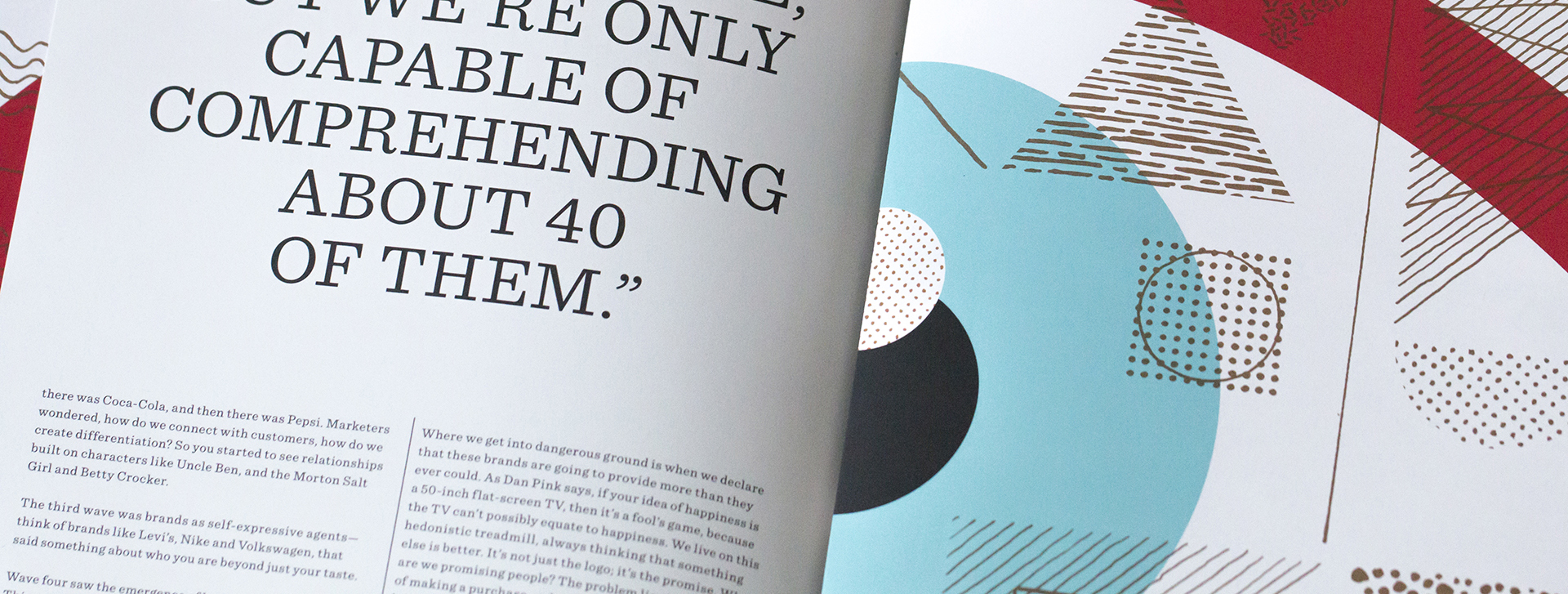In your book, “Brand Thinking,” you talk about brand as “a squishy” concept—that word is such an accurate description! You also include a quote from Paul Duncan, who defines brand as “something you have an unexplained, emotional connection to.” Why is branding such a squishy, unexplainable, nebulous discipline?
First of all, it’s hard to do. I define branding as deliberate differentiation, and therefore you have to make very specific, thoughtful decisions about how you’re creating that differentiation. Most differentiation isn’t really deliberate; it’s just a point of view, or a reason for being or an attribute that’s just descriptive and not differential. Branding is a process, a discipline. It’s a mashup of four related disciplines that come together to create the most engaging result: cultural anthropology, behavioral psychology, economics and creativity.
Perception has two components: sensory input and interpretation—and it’s the interpretation that’s very murky because it’s so individual. Interpretation is at the heart of branding. What are the ways brands influence how we interpret their messages?
Yes, perception is murky. But perception is also essential to us as a species. We self-select the things we want to see as a function of survival. Our brains have the capacity to see about 10 million images at a given time, but we’re only capable of comprehending about 40 of them. So we live in a constant state of self-selection. It’s what happens when you can’t find your keys, when they might well be right in front of you.
Perception is socialized—we learn to see the things around us and understand their significance or meaning. We’re not born with the construct of pink being for girls—we’re socialized in that. We’re not born with the ability to innately find something attractive, it’s socialized.
You’ve done extensive research into the history of branding and how elements like logos and taglines have come to influence the way we perceive a company. Can you give us a quick rundown of some of the key events or eras in branding?
In the late 1800s, the Trademark Registration Act marked the moment when trademark holders had legal protection and were allowed to own specific brands. I consider that the beginning of modern branding, and I’ve defined five different eras.
The first movement was brands as signifiers of consistency. You could expect a certain consistency if you bought a Coca-Cola in Detroit or New York City. And the fact that we had legal protection as consumers that ensured we could buy products that were not harmful meant that brands could represent quality and safety.
The next phase was about what I call brand anthropomorphism. Everyone saw that you could make money through establishing a brand, so you saw a lot of me-too brands: first there was Coca-Cola, and then there was Pepsi. Marketers wondered, how do we connect with customers, how do we create differentiation? So you started to see relationships built on characters like Uncle Ben, and the Morton Salt Girl and Betty Crocker.
The third wave was brands as self-expressive agents—think of brands like Levi’s, Nike and Volkswagen, that said something about who you are beyond just your taste.
Wave four saw the emergence of brands as an experience. This was the advent of brands like Apple and Starbucks and Disney, where the brand promises a sort of euphoria or emotional transformation for the consumer.
The fifth wave, which is still going on, is brand disconnector. Because we’re so consumed by our gadgets, we began to find ways to connect within those gadgets, and that gave rise to social media and brands like Facebook.
Brand managers, marketers and designers wield huge influence over how we perceive companies or products—there’s a lot of power there. In your book, Alex Bogusky talks about the bad actors that promote overconsumption and pitch harmful products. Where’s the line between using that influence over perception for good or evil purposes?
The interesting thing about branding is that even those movements like Adbusters or Buy Nothing Day are really using the very tenets of branding that they so vehemently disdain. So it’s not really about the specific ways in which we brand, because it’s all very similar, whether you’rebranding something for good or for bad.
Where we get into dangerous ground is when we declare that these brands are going to provide more than they ever could. As Dan Pink says, if your idea of happiness is a 50-inch flat-screen TV, then it’s a fool’s game, because the TV can’t possibly equate to happiness. We live on this hedonistic treadmill, always thinking that something else is better. It’s not just the logo; it’s the promise. What are we promising people? The problem lies in the psyche of making a purchase—when we value the construct or the belief system or the promise around the thing, and not the thing itself.
Maria Popova recently published a quote on BrainPickings.org from writer Henry Miller in his 1938 essay, “Money and How it Gets That Way,” and I think it sums up this treadmill:
“The dilemma in which we find ourselves today is that no matter how much we increase the purchasing power of the wage-earner he never has enough. If he has enough money to own a Ford he wants a Packard; if he has a Packard he wants a Rolls Royce, and if he has a Rolls Royce he wants an aeroplane…Men imagine that they need money, that if they had it they could satisfy their desires, cure their ills, insure their old age, and so on. Nothing could be farther from the truth.”























